Collective Grievance Letter
[Your Name]
[Your Address]
[City, State, ZIP Code]
[Email Address]
[Phone Number]
[Date]
[Recipient's Name]
[Recipient's Title]
[Company/Organization Name]
[Company/Organization Address]
[City, State, ZIP Code]
Dear [Recipient's Name],
Subject: Collective Grievance Letter
We, the undersigned members of [Company/Organization Name], write this letter collectively to express our shared concerns and grievances regarding certain issues that are affecting our work environment and overall well-being. As dedicated employees, we believe in the importance of a positive and respectful workplace that enables us to contribute our best efforts toward the success of the organization.
We acknowledge that our company has made significant strides in fostering a conducive work environment; however, there remain areas of concern that we feel require attention and resolution. We understand that open communication and collaboration are essential for the growth and success of any organization, which is why we have chosen to raise these matters collectively in the hope of fostering positive change.
Outlined below are the key grievances we wish to address:
1. **Inadequate Compensation and Benefits:**
Despite our hard work and commitment, we feel that our compensation and benefits packages do not adequately reflect our contributions and the current market standards. We kindly request a review of our compensation structure to ensure it is competitive and fair.
2. **Workload and Expectations:**
Many of us are facing unmanageable workloads and unrealistic expectations, leading to burnout and decreased job satisfaction. We propose a more balanced distribution of tasks and clearer communication of performance expectations.
3. **Lack of Professional Development Opportunities:**
We believe that investing in our professional growth is essential for both our personal development and the company's success. We request increased access to training, skill-building workshops, and career advancement opportunities.
4. **Communication and Transparency:**
There is a growing sense of disconnect between employees and management. We urge for improved communication channels, regular updates on company developments, and a platform for sharing our ideas and concerns.
5. **Health and Safety Concerns:**
Recent incidents and practices have raised concerns about our safety and well-being in the workplace. We seek a thorough assessment of health and safety protocols to ensure a secure and healthy environment for all employees.
6. **Diversity and Inclusion Initiatives:**
While there have been efforts to promote diversity and inclusion, more comprehensive strategies are needed to ensure a truly inclusive workplace that values and respects all employees, regardless of their background.
We, the signatories of this letter, sincerely hope that our concerns will be acknowledged and addressed in a timely and thoughtful manner. We believe that by working together, we can create a work environment that is mutually beneficial for employees and the company.
We kindly request a meeting to discuss these matters further and explore potential solutions. Our shared goal is to improve the workplace for everyone and contribute positively to the continued success of [Company/Organization Name].
Thank you for your attention and understanding.
Sincerely,
[Signatories' Names]
[Signature] [Date]
[Your Name] [Date]
[Co-signatory 1's Name] [Date]
[Co-signatory 2's Name] [Date]
[Co-signatory 3's Name] [Date]
[Co-signatory 4's Name] [Date]
... (continue with additional signatories if necessary)
CC: Human Resources Department
[Additional Relevant Departments/Individuals]
[Union Representative, if applicable]
Formal Collective Grievance Letter Regarding Workplace Conditions
Subject: Collective Grievance Submission from [Department/Team Name]
Dear [HR Manager/Employer Name],
We, the undersigned employees of [Department/Company Name], submit this collective grievance to formally raise concerns regarding current workplace conditions. Despite repeated informal discussions, issues persist concerning [specific concerns, e.g., safety, workload, working hours].
We request that management addresses these matters promptly and provides a clear action plan to improve the working environment. We are committed to engaging constructively to reach solutions that benefit both employees and the organization.
Attached is a list of all signatories and details of specific incidents or conditions that require attention.
Sincerely,
[Names of Representatives]
[Department/Team Name]
Collective Grievance Email for Salary Discrepancies
Subject: Collective Concern Regarding Salary Adjustments
Hi [HR Manager/Finance Department],
We, the undersigned employees, wish to bring to your attention inconsistencies in salary disbursements noticed over the past [time period]. Despite prior conversations, adjustments have not been reflected accurately.
We kindly request a review and clarification on the salary structure and timelines for correction. Our goal is to resolve this matter amicably and transparently.
Thank you for addressing our concerns promptly.
Best regards,
[Employee Representatives]
[Team/Department Name]
Serious Collective Grievance Letter on Workplace Harassment
Subject: Formal Grievance Regarding Workplace Harassment
Dear [HR Manager/Compliance Officer],
We, the employees of [Department Name], submit this grievance regarding instances of workplace harassment that have affected our team. Specific incidents include [briefly describe without naming individuals], which have created a hostile working environment.
We request an immediate investigation and implementation of preventive measures to ensure a safe and respectful workplace for all employees. We are committed to cooperating fully in this process.
Sincerely,
[Employee Representatives]
[Department/Team Name]
Preliminary Collective Grievance Letter for Review
Subject: Preliminary Submission of Grievances from [Team Name]
Dear [HR Manager/Employer Name],
This letter serves as a preliminary notification of grievances from the employees of [Team/Department Name]. Key issues identified include [brief summary, e.g., equipment shortages, procedural concerns].
We are submitting this initial document to facilitate dialogue and request guidance on formal procedures for resolution. A detailed list with signatures will follow upon your acknowledgment.
Thank you for your attention.
Sincerely,
[Employee Representatives]
Informal Collective Grievance Email About Workload
Subject: Team Concern Regarding Current Workload
Hi [Manager Name],
As a group, we want to highlight that the current workload has become unsustainable, with multiple overlapping deadlines and insufficient resources. This has impacted both productivity and morale.
We request a meeting to discuss workload distribution and potential adjustments. We hope to find a practical solution together.
Thanks,
[Team Representatives]
Heartfelt Collective Grievance Letter on Employee Benefits
Subject: Request for Review of Employee Benefits
Dear [HR Manager/Employer Name],
We, the employees of [Department Name], submit this collective letter to express concerns regarding current employee benefits. Many of us face challenges related to [specific benefits issues, e.g., health coverage, leave policies], which affect overall well-being.
We sincerely hope management will consider revising these benefits to support a healthier and more productive work environment. Our goal is to continue contributing effectively with confidence in organizational support.
Sincerely,
[Employee Representatives]
Quick Collective Grievance Email for Immediate Action
Subject: Immediate Attention Required: Collective Grievance
Dear [HR Manager/Employer Name],
We, the undersigned, request urgent attention to issues affecting our team, including [briefly list key concerns]. Delays in addressing these matters are impacting performance and morale.
We request a prompt meeting or written response outlining steps for resolution. Immediate action is highly appreciated.
Regards,
[Employee Representatives]
Professional Collective Grievance Letter for Policy Concerns
Subject: Collective Grievance Regarding Company Policies
Dear [HR Director/Employer Name],
We, the employees of [Department Name], submit this formal grievance regarding certain company policies that are adversely affecting our work efficiency and satisfaction. Specific policies include [list policies briefly].
We request a review and open discussion to evaluate potential modifications or clarifications. Our objective is to align policies with practical workplace requirements while maintaining organizational standards.
Sincerely,
[Employee Representatives]
What / Why: Purpose of a Collective Grievance Letter
- A collective grievance letter allows multiple employees to formally raise concerns jointly.
- It ensures management is aware of systemic issues rather than isolated complaints.
- The purpose is to seek resolution, fair treatment, and improvements in workplace conditions or policies.
Who Should Send a Collective Grievance Letter
- Employee representatives or elected team leaders.
- Groups of employees directly affected by the issue.
- Staff committees or union members if applicable.
Whom the Collective Grievance Letter Should Be Addressed To
- Human Resources department.
- Immediate managers or supervisors.
- Senior management or compliance officers, depending on the grievance.
When to Submit a Collective Grievance Letter
- When multiple employees are affected by the same issue.
- After informal attempts to resolve the issue have failed.
- During ongoing disputes affecting work conditions, policies, or compensation.
- For urgent matters requiring prompt attention or policy revision.
How to Write and Submit a Collective Grievance Letter
- Collaborate with affected employees to list concerns clearly and factually.
- Include specific examples, dates, and evidence if applicable.
- Maintain a professional tone even when raising serious concerns.
- Include names, signatures, and departments of all employees submitting the grievance.
- Submit through official channels (email, HR portal, or printed letter).
Requirements and Prerequisites Before Sending
- Agreement among employees on issues to raise.
- Documentation or evidence supporting the grievance.
- Understanding of company grievance procedures or policies.
- Appointment of representatives or spokespersons for communication.
Formatting Guidelines for Collective Grievance Letters
- Length: 1–3 pages, concise but detailed.
- Tone: Professional, respectful, yet assertive.
- Style: Formal for serious or policy-related grievances; slightly informal for minor concerns.
- Wording: Clear, factual, and free from personal attacks.
- Mode: Email for quick submissions; printed letters for official records.
After Sending / Follow-up Actions
- Request acknowledgment of receipt from HR or management.
- Schedule meetings or discussions to elaborate on concerns.
- Monitor progress and timelines for resolution.
- Keep a record of communications for reference or escalation if necessary.
Pros and Cons of Submitting a Collective Grievance Letter
-
Pros:
- Demonstrates unity among employees and seriousness of issues.
- Increases likelihood of management taking action.
- Provides a formal record of complaints.
-
Cons:
- May escalate tensions if not communicated carefully.
- Could impact relationships with management if perceived as confrontational.
Common Mistakes to Avoid
- Including personal attacks or emotional language.
- Failing to document incidents with specifics.
- Submitting without consulting all affected employees.
- Ignoring company grievance procedures or timelines.
Essential Elements and Structure of a Collective Grievance Letter
- Introduction: Identify the group and purpose of the letter.
- Description of Issues: List specific grievances with evidence or examples.
- Impact Statement: Explain how issues affect employees and workflow.
- Request for Action: Outline desired outcomes or corrective measures.
- Signatures: Names and departments of all signatories.
- Attachments: Any supporting documentation.
Tricks and Tips for Effective Collective Grievance Letters
- Keep the letter concise but comprehensive.
- Use bullet points for clarity in listing concerns.
- Maintain a respectful and factual tone throughout.
- Highlight solutions or constructive suggestions where possible.
- Coordinate signatures and maintain transparency among all employees involved.
Does a Collective Grievance Letter Require Authorization?
- Generally, internal HR acknowledgment is necessary to initiate formal proceedings.
- Union or employee representative authorization may strengthen the letter’s credibility.
- Signed letters by multiple employees indicate collective agreement and legitimacy.

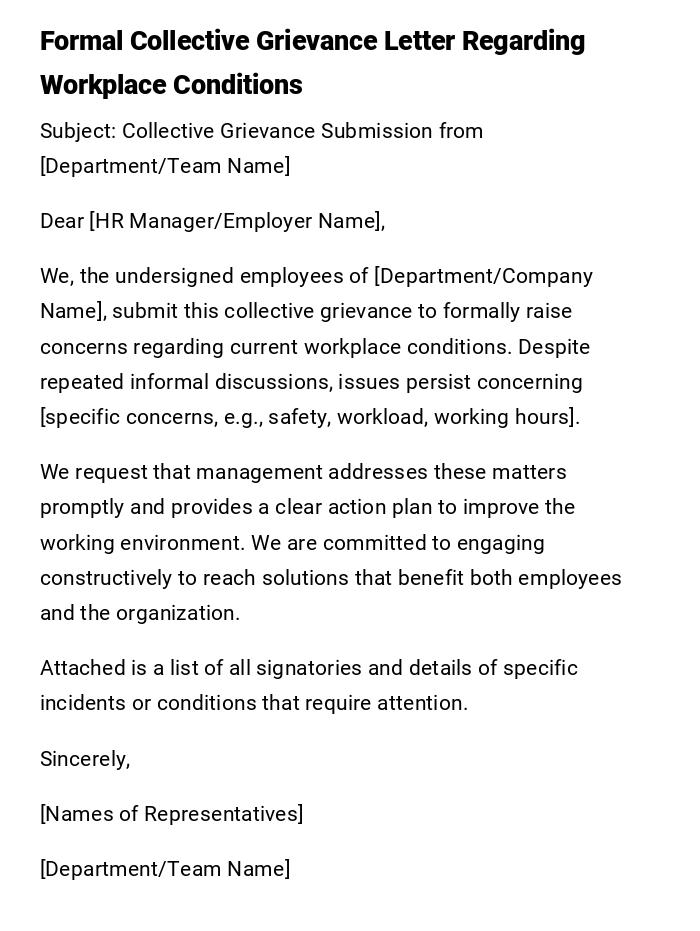
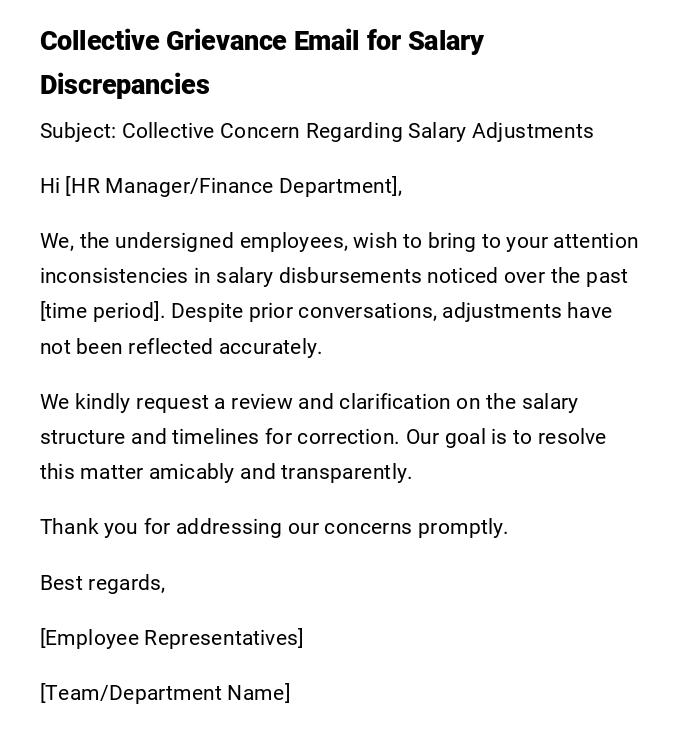
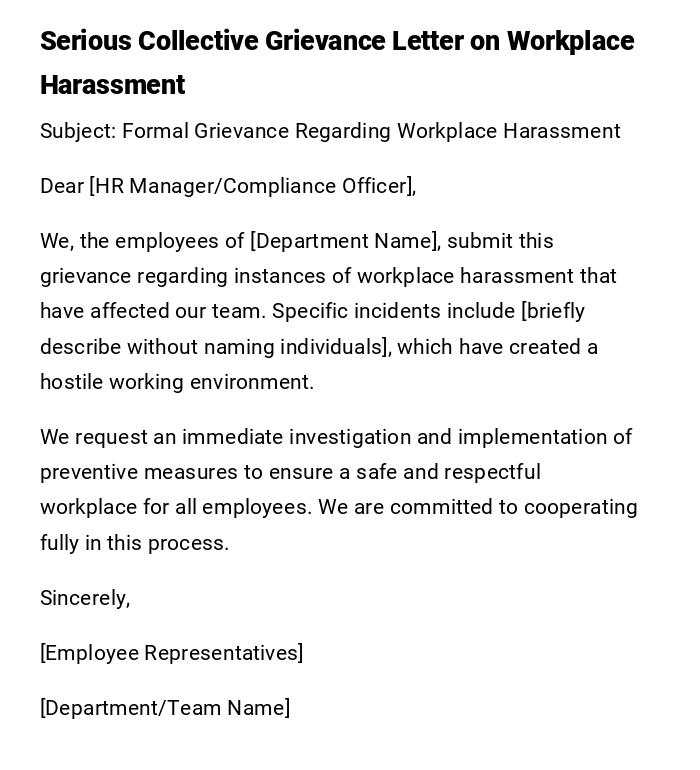
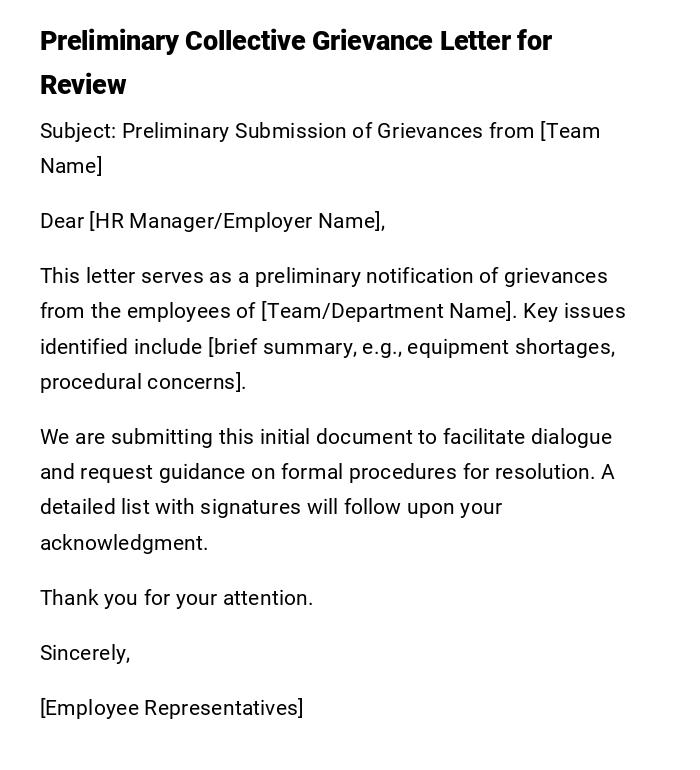
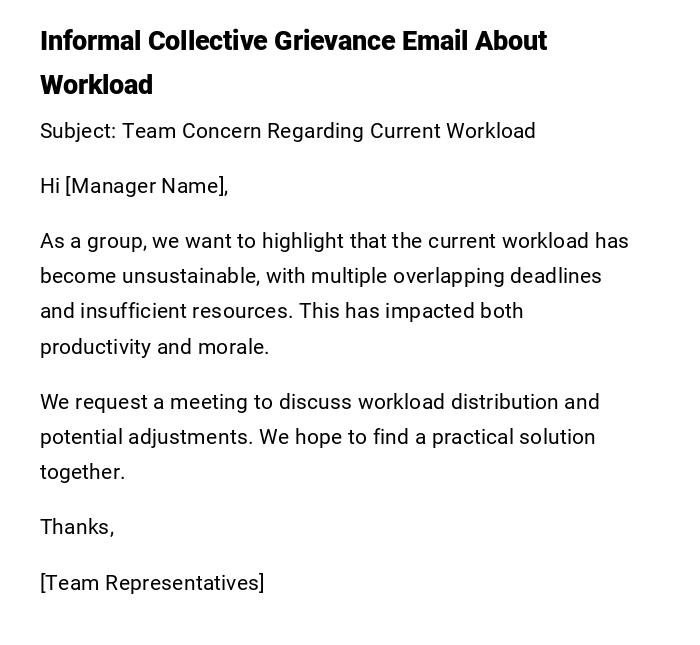
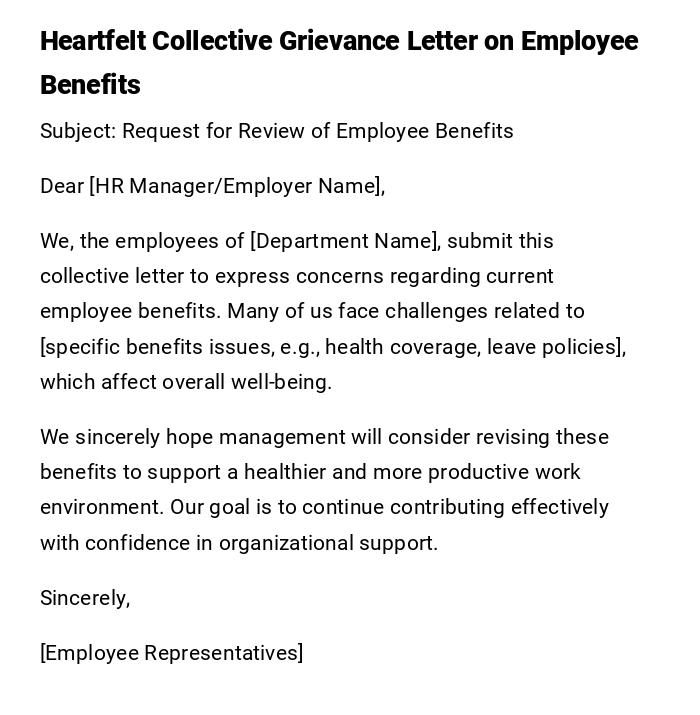
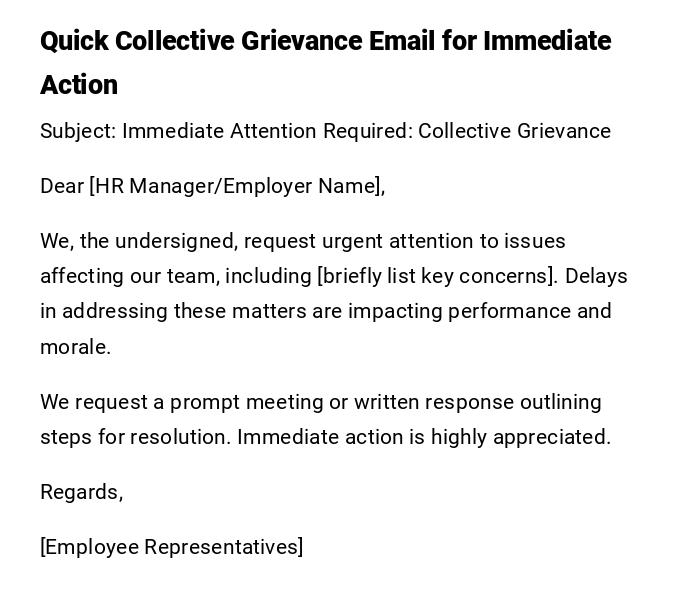
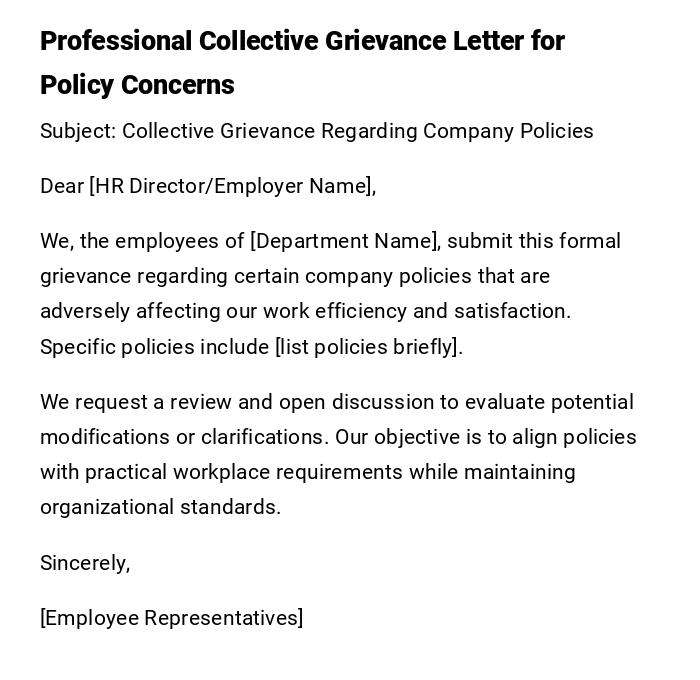

 Download Word Doc
Download Word Doc
 Download PDF
Download PDF